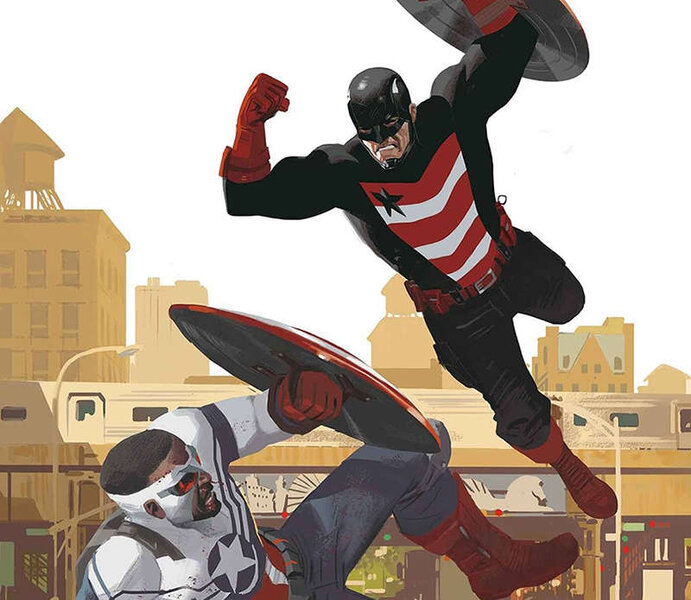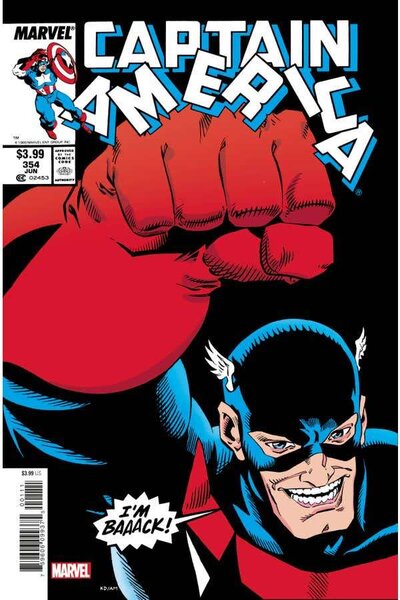Create a free profile to get unlimited access to exclusive videos, sweepstakes, and more!
The Falcon and the Winter Soldier villain U.S. Agent has always explored the dark side of Cap's patriotism

The Marvel Cinematic Universe may no longer have a Captain America, but when The Falcon and the Winter Soldier premieres on Disney+, we'll learn who will carry on Steve Rogers' legacy. Will it be Anthony Mackie's Sam Wilson, aka the Falcon? Will Steve Rogers' best friend, Sebastian Stan's Bucky Barnes, aka the Winter Soldier, take up the mantle? Or, could it be a newcomer? Trailers for the series imply that it will be taking major cues from a famous run of Captain America comics from the late '80s. That means Sam and Bucky should get ready to contend with a character known as U.S. Agent.
By the mid-1980s, Captain America had wrestled with enemies like the Red Skull, Baron Zemo, and HYDRA, but fans had gotten bored with the character, some even calling for then-writer Mark Gruenwald to "Rambo-ize" Cap. For Gruenwald, a passionate fan of Captain America, that would have gone against everything Steve Rogers stood for. Instead, he wrote an arc known as "The Captain," which spanned Captain America Issues #332-350, to explore the difference between Cap's ideals and the political reality during that arc. Additionally, he wanted to satiate fans who were looking for an edgier Cap but knew that he'd have to create a new character to do that.
Enter: John Walker.
A soldier without a war, Walker grew up idealizing his older brother who served and was killed in Vietnam. When he got the opportunity to become a super soldier in the vein of Nuke and G.I. Max before him, Walker jumped at the chance. Making his debut as the Super Patriot (Captain America #322, 1968), Walker would go on to replace Captain America for an extended period of time when Steve Rogers gave up the shield. Walker eventually teamed up with the original Cap before being targeted and presumably killed by the Red Skull.
However, this being comics, that wasn't the end of Walker's story. A shadowy government cabal reactivated and mind-wiped Walker, who would go on to become the U.S. Agent, making his debut as the character in Captain America #354 (1968).
Gruenwald, who died in 1996, said he wrote the overarching story to show that even though Captain America represented patriotism, it's not always a good concept.
"I was going to show the dark side of patriotism, and thought the way to do that was to have another character who was just as patriotic as Captain America, who embodied the dark side of the American Dream," Gruenwald told Amazing Heroes in 1988. "Walker comes from the point of view 'my country, right or wrong.' To Steve Rogers, America is a land where you have the opportunity to live up to your potential, to acquire all the things you want out of life provided that you don't step on other people's American Dreams to do it. Walker is different. He believes the American Dream is to make a mint and then retire... That's why he got into it."
In addition to creating a new version of Cap, Gruenwald wanted to present the First Avenger with weightier villains who represented real-world threats to America itself, including Flagsmasher (anarchy), the Serpent Society (corporate crime), Scourge (vigilantism), and Ultimatum (terrorism).
"The Captain" introduced a host of new foes for Captain America to battle, but U.S. Agent is by far the most complex — a twisted reflection of the all-American hero, right down to his costume. Grunwald solicited help from artist Tom Morgan, who joined the series as the illustrator on Issue #332 after previously serving as the head of Marvel's art corrections department. A longtime reader of the comic, Morgan spent hours debating with Gruenwald what Walker's costume would look like.
"There were at least three other artists crammed into the office as well… and nobody could do it," Morgan tells SYFY WIRE, remembering the challenge of making a new Captain America costume. "The original Cap design was so strong that anything we did was a parody, with stars and stripes in circular designs."
Eventually, Morgan says, instead of trying to improve the old design, he landed on providing contrast. Replacing Steve's symmetrical star and stripes, Morgan designed a triangle flag with an offset star over one breast instead of centered.
"Horizontal stripes instead of vertical. Black instead of blue," he explains. "I showed Mark the rough design and described my thinking behind it. He agreed the idea of contrast was a strong way to go and still retain the flavor and integrity of Steve Rogers."
The costume, though different from the original, functions as both a Captain America uniform and a more villainous garment for his dark mirror. Morgan, for what it's worth, prefers the original Cap's.
"I like the notion for what the character stood for when Steve Rogers wore the mantle: strength and integrity," he says. "When the identity of The U.S. Agent was taken over by John Walker, I felt sort of cheated, as this character clearly was an opposite to the goodness of Steve Rogers. He was crude and prone to violence with an indifferent 'whatever' kind of attitude. I knew we had to have this character as a contrast to Steve, but I didn't like the guy. I would have liked to delve a little more into John Walker's background to flesh out the character more."
When he took over art duties for Morgan on Captain America #338, Kieron Dwyer was another fresh face at the Marvel offices. Like Morgan, Dwyer says that even though he was green, Gruenwald welcomed his input — and that his input helped make U.S. Agent a more twisted villain.
"He was super encouraging and supportive and always responded well to what I brought to the book, both artistically and in terms of my ideas," Dwyer tells SYFY WIRE, remembering his time working with Gruenwald. "I think once I started bringing in the more psychotic, dark energy to John Walker, it influenced how far around the bend Mark was willing to go with the character."
Dwyer explains that the character — and the entire story arc — came about because Gruenwald wanted to clarify to the public "what Captain America really means, what it takes to be Cap."
"Steve Rogers isn't Captain America because he wears the uniform," Dwyer says. "[You see that] when Walker — who is without any of the character or temperament — takes the job. Yet here he is, serving as an American icon because the government thinks they can install any old person with muscles."
In The Falcon and the Winter Soldier, actor Wyatt Russell will be playing the replacement American icon, and although trailers for the series haven't focused on John Walker all that much, set photos and tie-in merchandise have shown that he will wear the U.S. Agent costume — and presumably play a similar foil to Sam and Bucky.
Dwyer says he's excited for The Falcon and the Winter Soldier, especially if the series digs into the heart of Gruenwald's run. However, he's personally doubtful that Marvel Studios will touch such heavy topics — especially since America has changed in the 30 years since the original story arc, specifically in the past few years.
"Given the state of the country now and the political climate, it would be really interesting to see that explored through the lens of a character with ties to Captain America but who is a direct servant of the U.S. government," Dwyer says, thinking of politicians who encourage unrest "in the name of patriotism and not only seem to suffer no consequences but actually thrive."
Dwyer may be right in thinking that the Disney+ series won't be explicitly political, but U.S. Agent, from the start, has been a political character. When he appears in The Falcon and the Winter Soldier, we'll see what the MCU thinks about its version of patriotism — and what that means in the real world three decades since John Walker first embodied all of Captain America's contradictions.




























